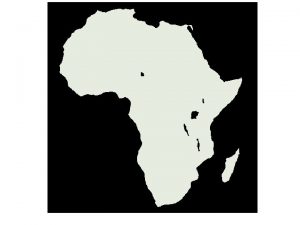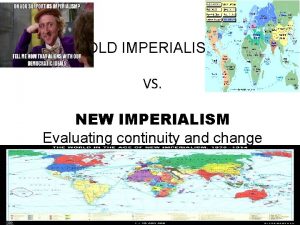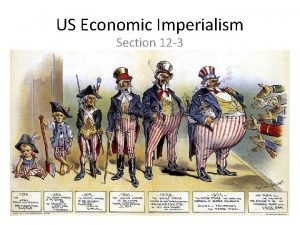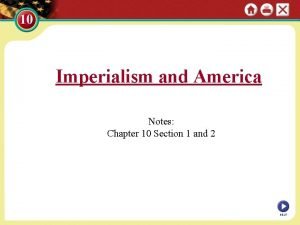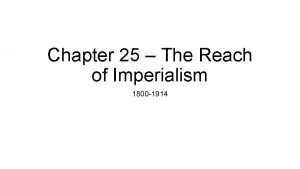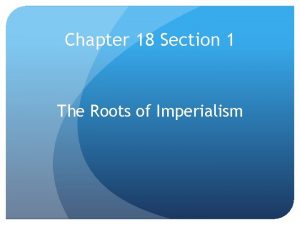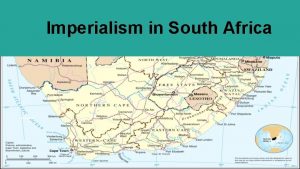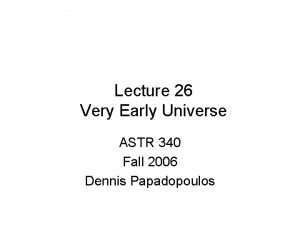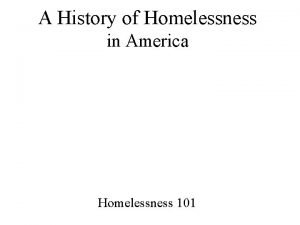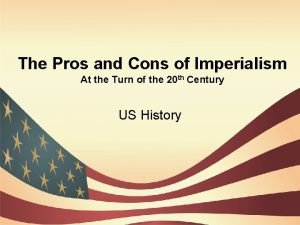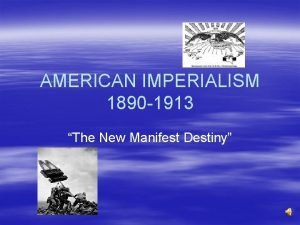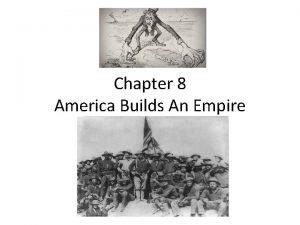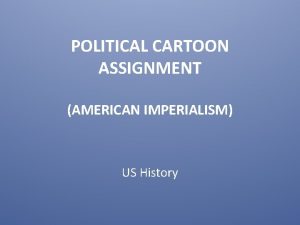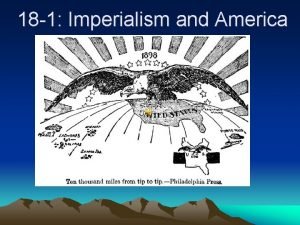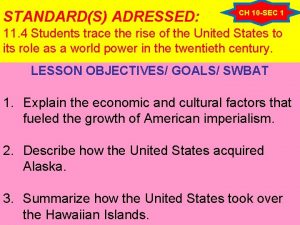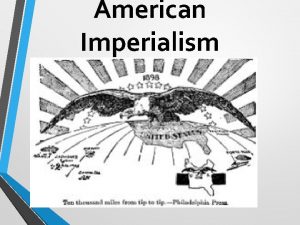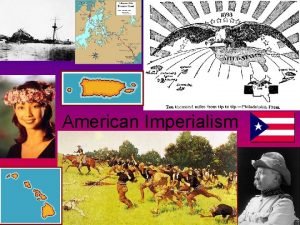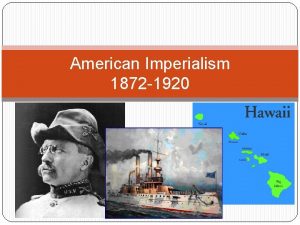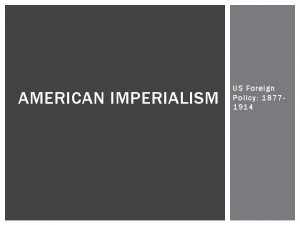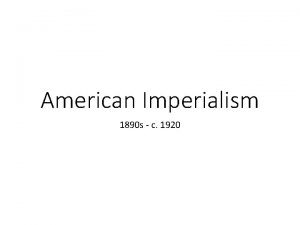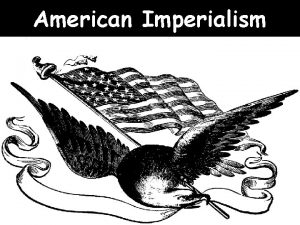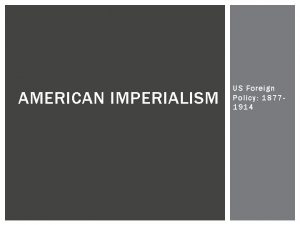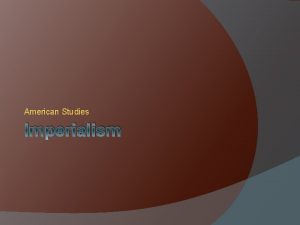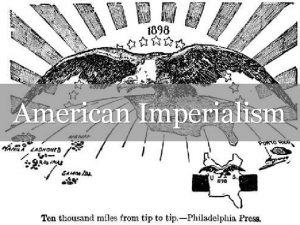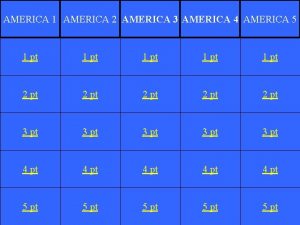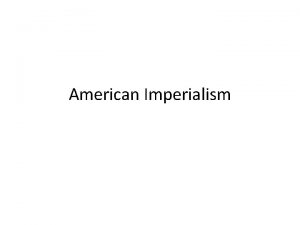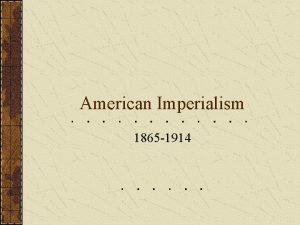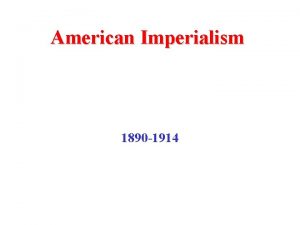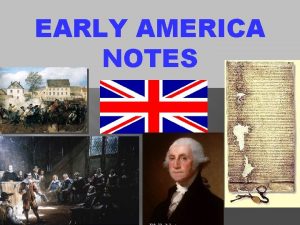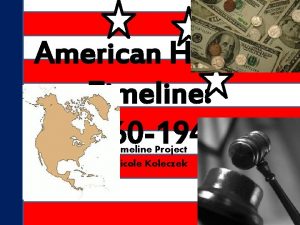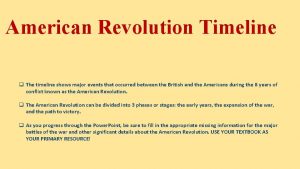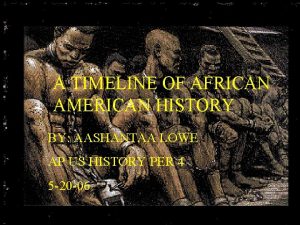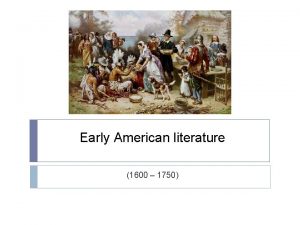American Imperialism Imperialism in America Timeline Early imperialism































- Slides: 31

American Imperialism

Imperialism in America - Timeline • Early imperialism called Manifest Destiny – to expand from “sea to shining sea. ” • Western Frontier: Indian wars, the Mexican War and the Civil War have been called examples of such imperialism. • Pacific Ocean: • Americans took control of Hawaii in late 1880’s. • In 1853 Commodore Matthew Perry opened up trade with Japan by threatening military action • Fought a war with Spain in 1898. Acquired the Philippines, Guam and Puerto Rico. (Spanish American War)

Japanese Imperialism

Background: Japan • Tokugawa family ruled Japan from 1603 until 1868 – also known as the Edo period • 1635 – foreign trade limited to China, Korea, and Netherlands at Nagasaki a few times per year – Japan practiced isolationism • Emperor Mikado ruled in name only, the actual power held by the shogun

Japanese Feudalism Samurai – lived by Bushido, the “way of the warrior” (chivalric code) Shogun (military governor) Ronin – those samurai without masters Daimyo/Lords Samurai Peasants, Merchants, etc. Ninja – a warrior trained to use unorthodox fighting methods (assassination, espionage, martial arts)

Japanese Culture and Economy Religion • Mix of native Shintoism (living spirits in all things) and Chinese Confucianism (based on the teachings of Confucius) • “Our greatest glory is not in never falling, but in getting up every time we do. ” Economy • Growing internal trade during the Edo period • Merchants began to surpass the samurai in wealth Rigid social stratification • Strict social classes were being tested by the end of the Tokugawa shogunate

End of Japanese Isolation - 1854 The Treaty of Kanagawa Ø In Tokyo, Commodore Matthew Perry, representing the U. S. government, signs this treaty with Japan Ø opens Japanese ports to American trade Ø permitted the establishment of a U. S. consulate in Japan Ø opened Japan to trade with the United States, and thus the West

Japanese Reaction Pros Cons Acquiring Western knowledge became very popular among many doctors, scholars, and scientists Western knowledge went against many traditional Japanese beliefs Japanese entrepreneurs, merchants, and industrialists profited from increased trade Traditional holders of prestige and power (daimyos and samurai) did not tend to profit from increased trade Resentment • Extraterritorial rights of Americans and Europeans • Anti-foreign uprisings (1863 -1864) • Japanese ports in turn bombarded by foreign ships Solution • “If you can’t beat ‘em, join ‘em” • Japanese could benefit from knowledge of what happened to China • Japanese felt that they would be in a better position to renegotiate the trade treaties, and be less likely to be imposed upon, if they adopted Western ways (democracy, imperialism, industrialization, militarization, and modernization) – westernization

Consequence of Westernization Meiji Restoration • Shogun forced to relinquish power • Power officially in hands of Emperor Mutsuhito • His reign was called the “Enlightened Rule” • Japan westernized

The Emperor Is “Restored” to Power MEIJI “Enlightened Rule”

Newspaper Cartoon, 1870 s? Enlightened Half-Enlightened Un-Enlightened

The Japanese Became Obsessed with Western Styles Civilization and Enlightenment!

Everything Western Was Fashionable!

The Rulers Set the Tone with Western Dress Emperor Meiji Empress Haruko (1868 - 1912)

Meiji Era: Governmental Reforms • Diet – Japan’s bicameral (2 branches) legislature – First convened – 1889 • Meiji (Imperial) Constitution – Adopted – 1890 – Followed until the end of World War II

Meiji Era: Economic Reforms Abolition of feudalism Currency (yen) adopted, 1872 Encouragement of foreign trade Expansion and encouragement of industrialization • Growth of factories • • o First large factories manufactured textiles o First textile factory workers were girls and women

Meiji Era: Military Reforms • Before the Meiji era: Armies were run by local daimyo (lords) and thus not obedient to a central government • Modern army and navy established which were loyal to the Japanese government • Used Prussia (Germany) as primary model • Firm belief that if Japan was to be taken seriously by Western powers, and was to avoid China’s fate, Japan would have to compete militarily • Conscription (1873) – all men had to serve for three years after turning twenty-one

Meiji Era: Social Reforms • Compulsory (mandatory) elementary education • Universities established • Westernization of many laws Tokyo University

Meiji Era: Social Changes • Adoption of Western architecture, fashions, music, and literary styles (magazines and novels) • Diversity of intellectual and political thought • Growing independence and empowerment of women • Movement of peasants from countryside to factories

Imperialization of Japan • Why? – Lack of fertile land for agriculture – Need markets for finished products – Need for the raw materials of industry – Population growth – Response to Western imperialism

Japanese Imperialism: “If you can’t beat ‘em, join ‘em” • First Sino-Japanese War (1894 -1895) • Sino- China • Gained: Ø Formosa (Taiwan) Ø Liaotung Peninsula (Manchuria) – soon forced to relinquish it Ø Sphere of influence in Korea Ø Sphere of Influence- When a powerful country has economic/political influence over an area. (Not TOTAL control)

Japanese Imperialism: “If you can’t beat ‘em, join ‘em” • Russo-Japanese War (1904 -1905) • Destroyed Russian naval fleet • Finally respected as a world power • Treaty of Portsmouth, 1905 o U. S. President Theodore Roosevelt won Noble Peace Prize o Japan was granted the southern part of Sakhalin Island a large sphere of influence in Manchuria

President Teddy Roosevelt Mediates the Peace The Treaty of Portsmouth, NH ended the Russo-Japanese War.

Japanese Imperialism: “If you can’t beat ‘em, join ‘em” • Ignored international treaties – built up navy • Marco Polo Bridge Incident – July, 1937 – Minor dispute between Chinese and Japanese troops – Neither side would back down – Started the Second Sino-Japanese War (during WWII) • U. S. reaction – Americans boycotted Japanese goods – American companies continued to sell Japan cotton, oil, and scrap metal

But, Japanese Power Would Grow. . .

Japanese Sphere of Influence

BRITISH IMPERIALISM

British Imperialism in India Positives • Established order • built roads, schools, bridges, railroads, factories, and hospitals • introduced new farming methods Negatives § Racism § Discrimination § Segregation

British in India • British East India company controlled much of India using sepoys. • Sepoys – Native Hindu or Muslim mercenary private police • Crops: – opium poppies for sale in China – cotton and tea for sale in the rest of the British empire • Cotton textile making outlawed in India • India was so profitable, it was called the “Jewel in the Crown. ”

Imperialism and Empire - India • The Sepoy Rebellion allowed British soldiers to invade and control all of India • The British established control of India and its neighbors by 1914. • The British also controlled Australia, New Zealand much of the far east. • The worlds’ biggest empire!

Work Cited • www 4. alief. isd. tenet. edu • www. studenthandouts. com/powerpoint/JAPA N. ppt • mrhamlett. net/Imperialism_Asia. pdf
 Old imperialism motives
Old imperialism motives Old imperialism motives
Old imperialism motives Early cpr and early defibrillation can: *
Early cpr and early defibrillation can: * South american map
South american map Chapter 10 section 1 imperialism and america
Chapter 10 section 1 imperialism and america Chapter 25 the reach of imperialism
Chapter 25 the reach of imperialism Roots of imperialism
Roots of imperialism Chapter 10 section 1 imperialism and america
Chapter 10 section 1 imperialism and america Chapter 4 oklahoma in early america
Chapter 4 oklahoma in early america African imperialism timeline
African imperialism timeline America america you mean the world to me
America america you mean the world to me America 2 europe
America 2 europe Repetition in let america be america again
Repetition in let america be america again Why is it called latin america
Why is it called latin america Happening body art
Happening body art Early explorers timeline
Early explorers timeline Early universe timeline
Early universe timeline Timeline of homelessness in america
Timeline of homelessness in america Cons of imperialism
Cons of imperialism What three factors spurred american imperialism
What three factors spurred american imperialism Roots of american imperialism
Roots of american imperialism American imperialism definition
American imperialism definition Chapter 8 american imperialism vocabulary
Chapter 8 american imperialism vocabulary American imperialism political cartoons explained
American imperialism political cartoons explained What does the picture depict
What does the picture depict The roots of american imperialism economic roots
The roots of american imperialism economic roots Expansionism
Expansionism American imperialism 1800s
American imperialism 1800s Alaska american imperialism
Alaska american imperialism Flemish floral design
Flemish floral design European floral design history
European floral design history Early american period floral design
Early american period floral design
